Note: This portfolio site was launched on 30th March 2025. More stories, resources, and portfolio updates will be added progressively as I move forward and subject to available personal time.
MCP in Action: Seamless AI Integration for Automation and Beyond
This article delves into the Model Context Protocol (MCP), highlighting its purpose, architecture, and key components. Gain a clear understanding of how MCP standardizes and simplifies connections between large language models and various external resources, offering a unified framework for efficient, secure, and scalable AI integration.
TECHNICAL
Kiran Kumar Edupuganti
6/30/20254 min read


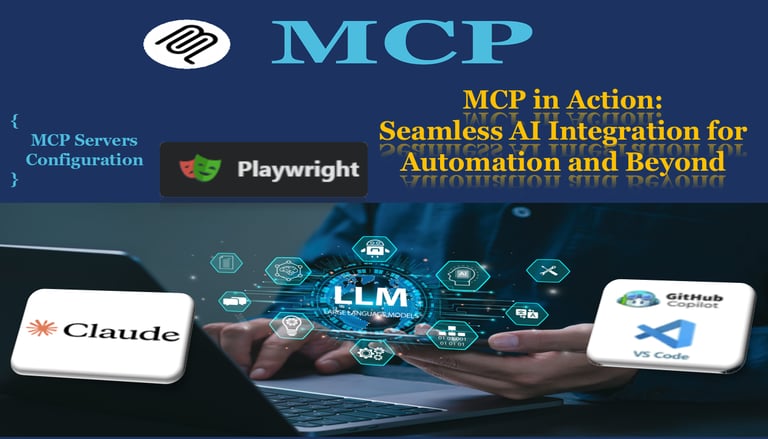



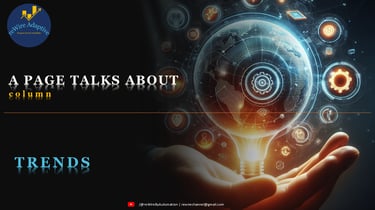

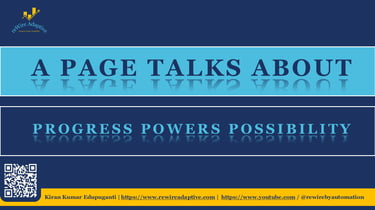

MCP Demystified: Configuration & Application
The portfolio reWireAdaptive, in association with the @reWirebyAutomation channel, presents an article on MCP Integration with LLMs. This article, titled "Seamless AI Integration for Automation and Beyond," explores how MCP extends the capabilities of LLMs in the AI Era.
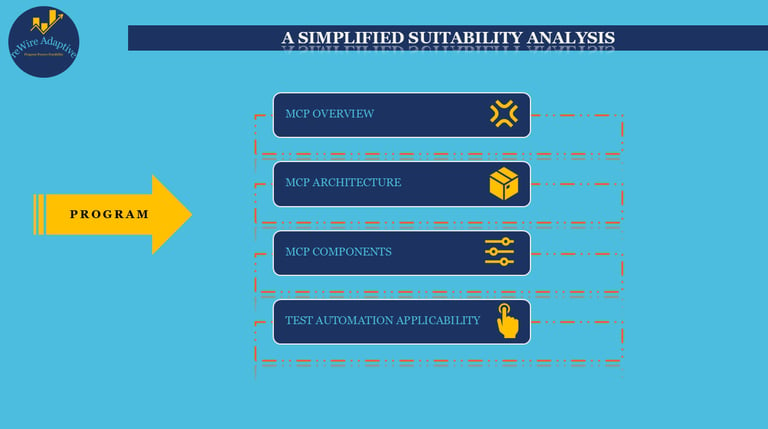

MCP Overview
Introduction
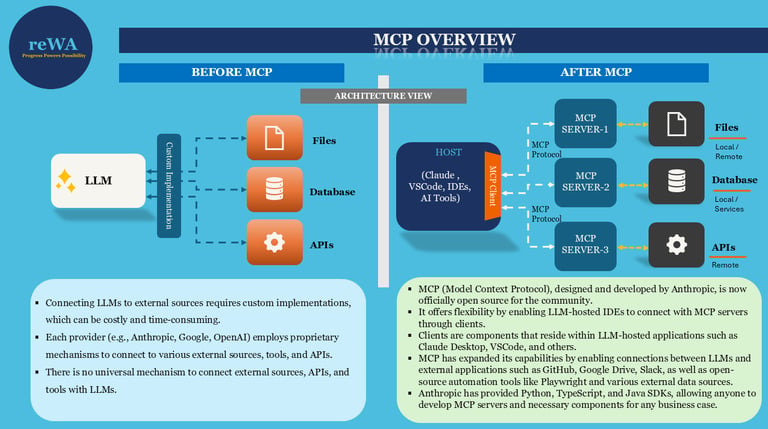

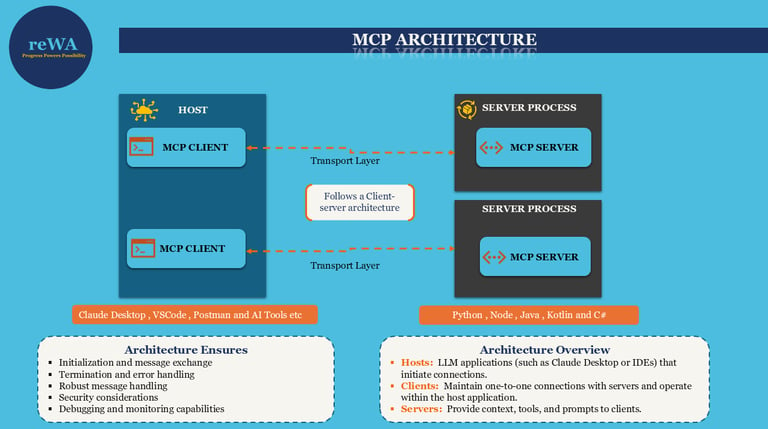

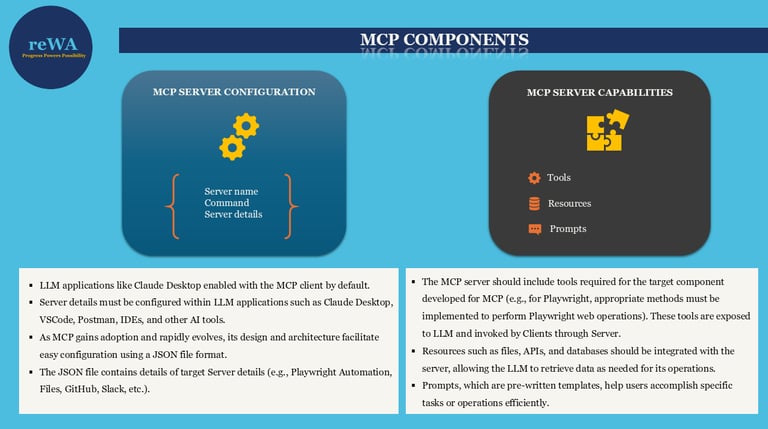

Before MCP, each provider or application often had to build custom integrations to connect LLMs with external sources. This approach was both costly and time-consuming, which limited its widespread adoption. MCP changes the landscape by introducing a unified protocol, making it possible for any LLM-enabled application to connect with a wide range of external resources using a common, standardized method.
MCP follows a client-server architecture designed for reliability and scalability.
Clients: Embedded in LLM-enabled applications, these handle communication with MCP servers.
Servers: These deliver a range of tools, resources, and prompts for various operations—such as automation, data retrieval, or business logic execution.
Resources: These can include files, APIs, databases, and more, made available to LLMs through the protocol.
Prompts: Pre-written templates help guide LLMs to accomplish specific tasks quickly and accurately.
MCP’s open nature means it is supported by an ever-growing list of AI and developer tools. The protocol is designed to integrate seamlessly with popular platforms such as GitHub, Google Drive, Slack, Playwright for automation, and many more via Claude Desktop, VSCode, IDEs, and AI Tools. This flexibility allows organizations and developers to build customized workflows that leverage both AI and the power of external systems.
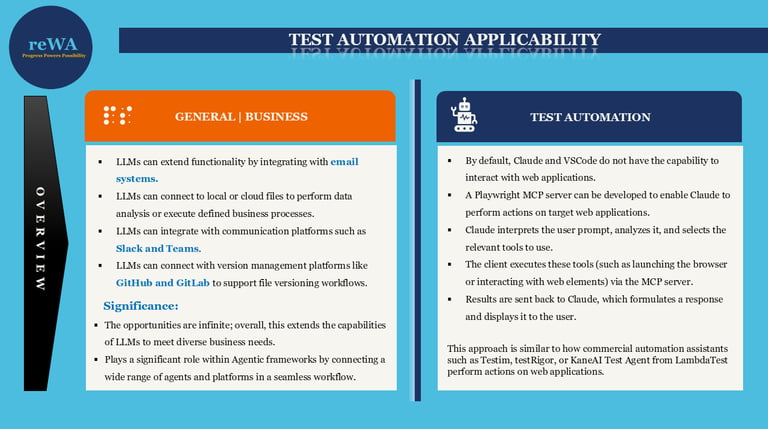

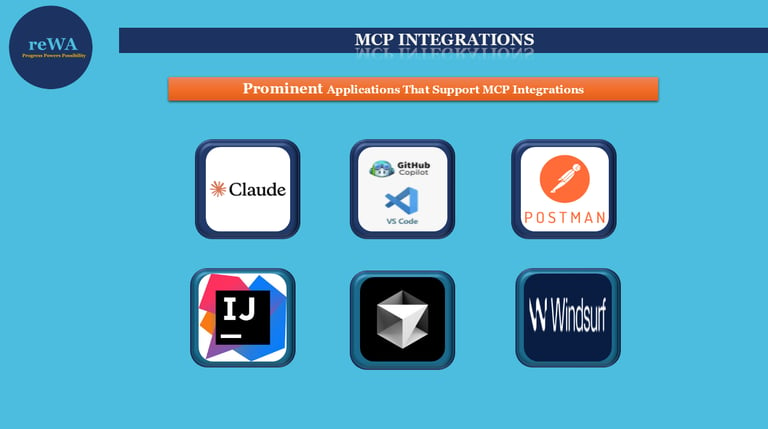

The Model Context Protocol (MCP) is an innovative open-source standard, designed and developed by Anthropic, to simplify and standardize how Large Language Models (LLMs) connect with external tools, data sources, and applications. As LLMs like Claude, OpenAI’s models, and other AI tools grow in capability, the need for a universal way to connect these models with files, databases, APIs, and business applications has become essential. MCP addresses this challenge, bringing flexibility, efficiency, and scalability to AI integration.
With MCP, integration is streamlined and more accessible. Applications such as Claude Desktop, VSCode, Postman, and other IDEs can now connect with external systems through well-defined interfaces, enabling richer user experiences and unlocking new use cases for AI.
MCP Architecture
Hosts: These are LLM applications (like Claude Desktop or various IDEs) that initiate the connection process.
Clients: Operating within host applications, clients establish and maintain direct, one-to-one connections with MCP servers.
Servers: MCP servers provide the necessary context, tools, and prompts to the clients, acting as a bridge between LLMs and the outside world.
The architecture is built with a focus on robust initialization, secure message exchange, termination, and error handling, detailed message handling, security considerations, and comprehensive debugging and monitoring capabilities. This ensures seamless and dependable operation across different use cases and environments.
MCP Components
MCP Integrations
Test Automation Applicability
One of the most impactful use cases for MCP is in test automation. Traditionally, LLMs like Claude or IDEs like VSCode cannot interact directly with web applications. However, by leveraging an MCP server (for example, with Playwright), these tools can now automate browser tasks, interact with user interfaces, and perform test execution, much like specialized commercial tools such as Testim, UiPath(AutoPilot), or KaneAI from LambdaTest.
MCP enables LLMs to interpret prompts, select relevant tools, execute tasks via the MCP server, and deliver results back to users, making test automation more accessible and efficient.
Significance
MCP is a major advancement in the AI ecosystem, extending the capabilities of LLMs to meet diverse and evolving business needs. By enabling easy, standardized integration with a wide range of tools and data sources, MCP empowers businesses, developers, and end-users to create smarter, more connected, and more efficient workflows, ushering in a new era of intelligent automation.
References
Final Insights: This article concludes by emphasizing the importance of hands-on experience in configuring MCP servers and applications for both automation and general-purpose workflows. The primary takeaway is the practical value of applying MCP to orchestrate and integrate LLMs with open-source automation, ensuring seamless connectivity with various external systems. By simplifying these integrations, MCP empowers users to unlock broader possibilities for workflow automation and enhances the capabilities of modern AI solutions.
| Refer to the infographic embedded for Final Insights:

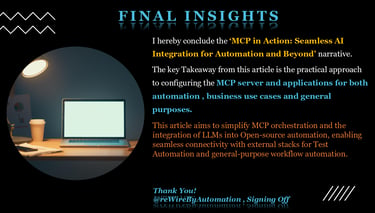

Please refer to the voiceover for the “MCP Demystified: Configuration & Application” session available on the @rewirebyautomation YouTube channel.




Stay tuned for the next article and session from rewireAdaptive
This is @reWireByAutomation, (Kiran Edupuganti) Signing Off!
With this, @reWireByAutomation has explained a “MCP in Action: Seamless AI Integration for Automation and Beyond” from an AI-powered automation objective perspective.
